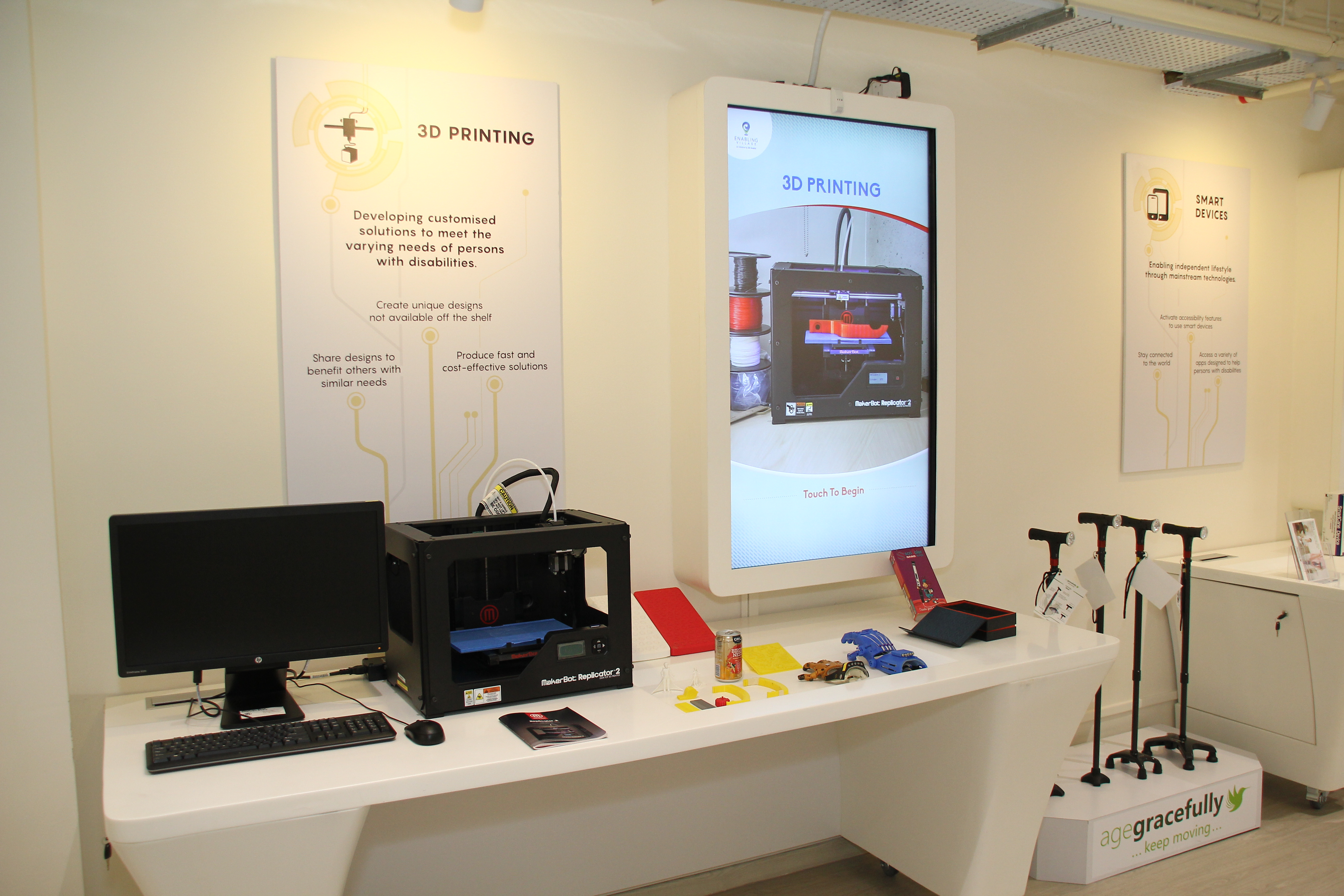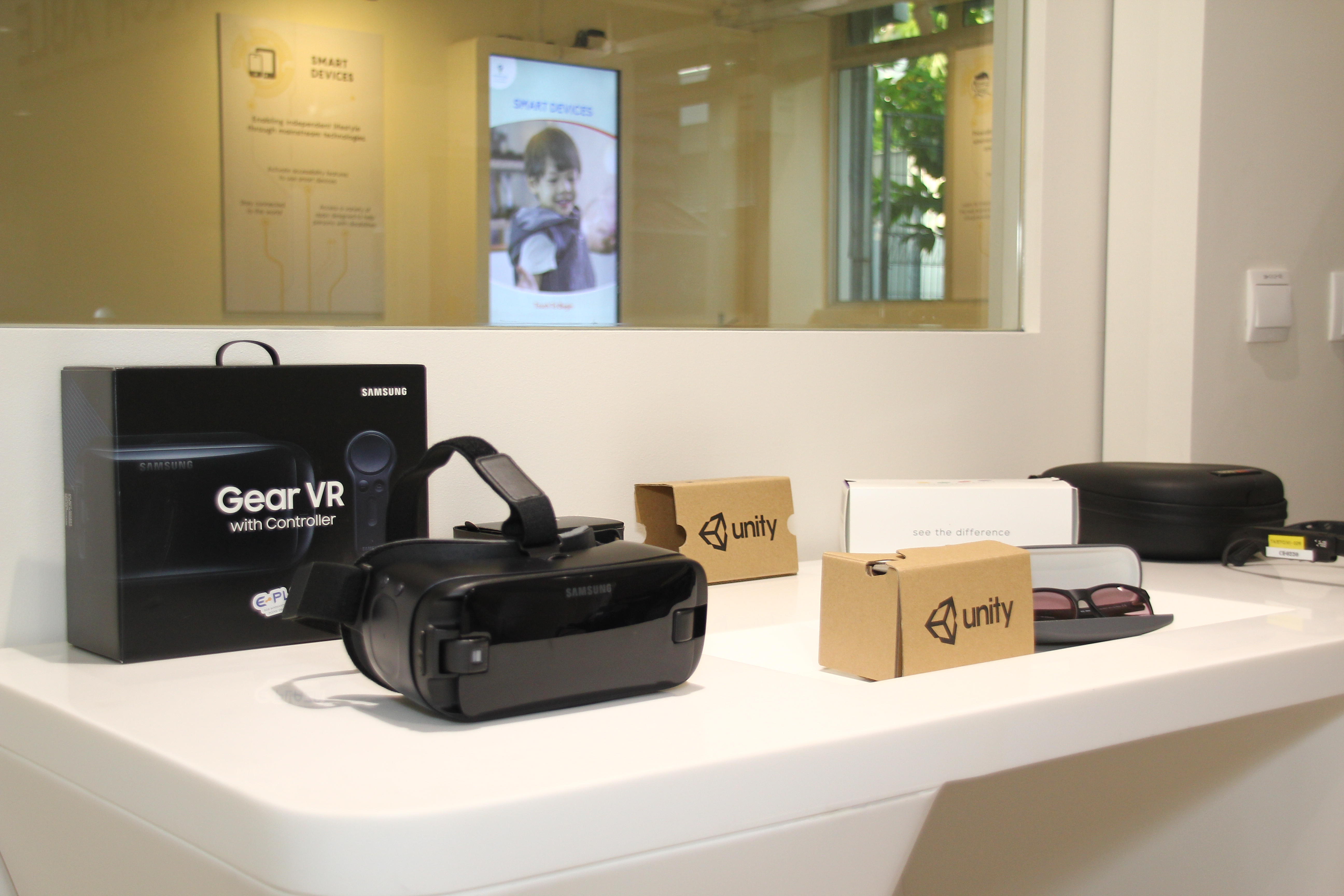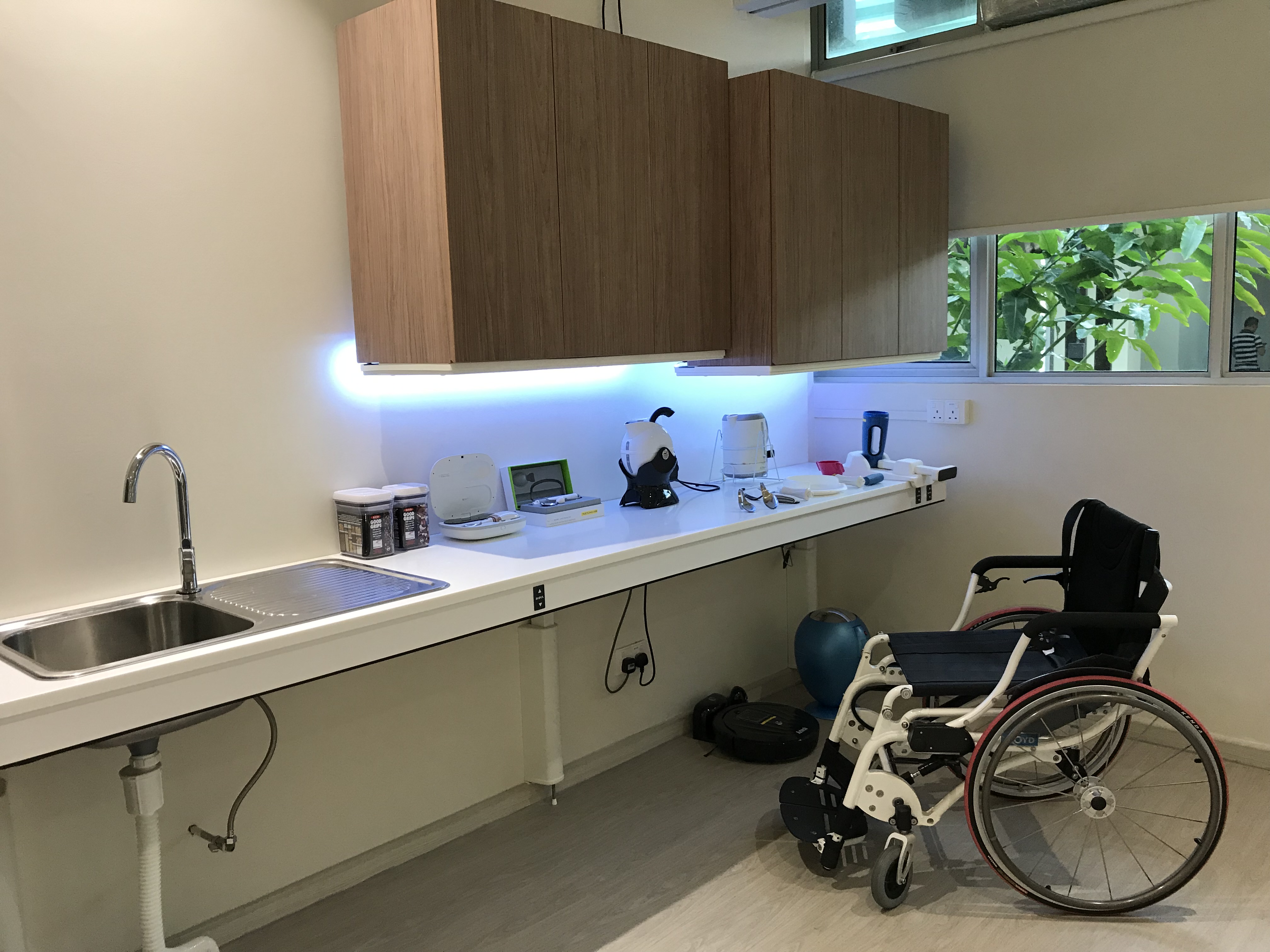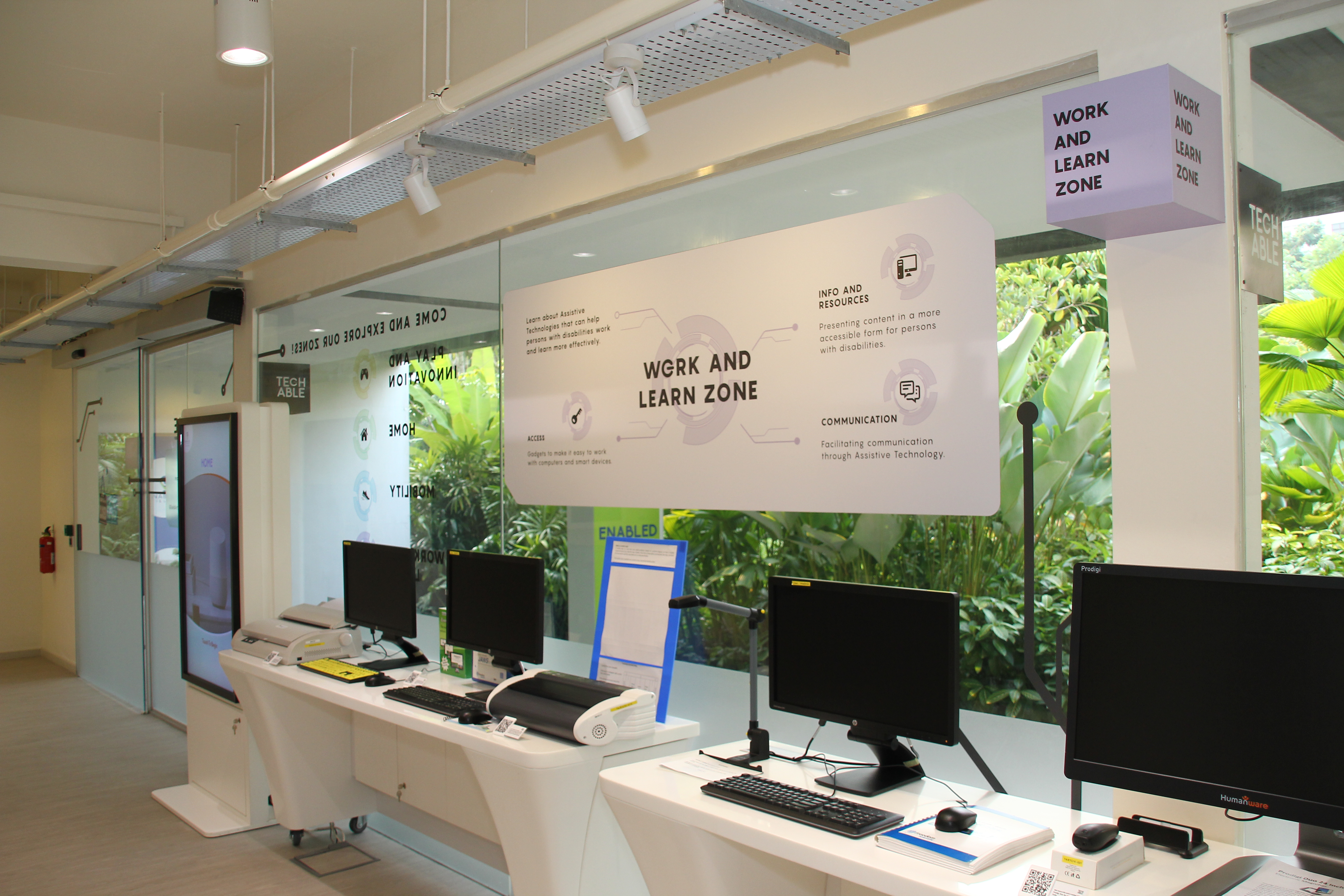Back in March 2020, with things scaling down due to the COVID-19 situation, Tech Able was closed to the public. Since the makeover of Tech Able in August 2019, I had yet to tour it. I asked my colleagues at Tech Able if they could arrange a little tour for me. They agreed and it was a very engaging and educational session.
Tech Able is a rectangular space divided into four Zones - Play and Innovation, Work and Learn, Home and Mobility. I shall try my best to describe each of the zones in detail later.
When you first enter Tech Able, you will be standing in front of a tactile map of Tech Able. It is a 1m by 42cm display, depicting a very detailed map of the space. Above us at various sections of the zones, there are audio directional speakers which broadcast descriptions of our surrounding, giving visitors who are standing under them a good idea of the assistive devices.
I started off at the Play and Innovation Zone. My colleague Justin gave verbal explanations of the different items on display which another colleague Alvin kindly recoded into text for me on my braille device. The Play and Innovation Zone showcases innovative solutions such as 3D printing. I visualised a 3D printed currency note case where you place a note into it and based on the length of the note, one could differentiate the various values.

Besides 3D printing, there were numerous smart wearables such as virtual reality (VR) glasses. Justin then showed me a smart walking stick in the form of an umbrella. The umbrella could be removed from the walking stick. The walking stick also comes with added functionalities like a torchlight, a built-in radio and an alarm, which is activated with a sound when the user or walking stick falls.

We then headed over to the Home Zone. In the kitchen of the zone, I was shown the height-adjustable counter top and cabinets which could be lowered for easy reach. There are safety mechanisms so you will not bang and hurt yourself when the cabinets are being lowered. The way some refrigerators are designed makes it hard for users to open the doors. With a simple add-on gadget like suctions handles, we can now open the fridge door with ease. Putting rubber grips on spoons or forks allow us to hold on to them easily. There are two versions of self-levelling spoons to make scooping food easy – a manual one that is based on the counter-weights on the sides of the spoon to balance it out and another electrical version. Sitting at the kitchen table which also has a height-adjustable feature, I saw two kettle holders which could make pouring of water easier and safer. One was a swinging frame for putting on any kettle or flask upright to be tilted for pouring water, while the other is the kettle itself which comes with its own stand that can be tilted when pouring water.

In the living room, I discovered a programmed virtual assistant called Alexa, that could control electrical appliances. By giving a simple voice command like, "Alexa, so hot", Alexa will turn on the fan. With a virtual assistant to control your appliances, you no longer need to fiddle around for switches which are often located at places that are difficult to reach or on the wall behind the appliance.
In the bedroom, the wardrobe has a pulley system which makes it easier for persons with disabilities to reach for the clothing on the hangers. The bedroom also showcases adaptive clothing for those with limited motor skills. There are also various alert systems which can notify the user of a ringing phone or someone knocking at the door through vibrations or flashing lights. Such alert systems can come with a vibrating sensor within or an additional gadget that can be placed underneath or in the pillow, to alert the user when someone knocks at the door.
The Mobility Zone, as you can tell from the name, mainly focuses on wheelchairs and you can find a small selection there. There are two types of wheelchairs - motorised as well as manual ones with add-ons to allow users to manage with lesser effort.
The last zone in Tech Able is none other than the Work and Learn Zone. The range of communications tools includes non and low tech communication board with alphabets for non-verbal users to spell, pictorial books to help with conveying needs, to high tech ones such as iPad, the EyeGaze system, communicator systems for the hearing and non-hearing. The different types of mouse and keyboards range from the mainstream gaming ones, those with large fonts on keyboards, varying colour contrasts, keys which run in alphabetical order, to smaller ones where you can type with one hand to the larger sized ones with larger keys. The assistive devices on display for the persons with visual impairment include refreshable braille displays, Optical Character Recognition (OCR) scanner, portable and non-portable magnifiers for persons with partial vision, and talking calculators for use in classrooms. I was impressed with the eCanvas invented by GovTech, which allows one to move the canvas and to dispense the paint with very simple voice commands with high level of accuracy.

It is impossible to list every single device which can be found in Tech Able. What is important is that assistive devices are useful and enable persons with disabilities in different aspects of their lives. In deciding on any suitable devices, we need to assess the device, test it and to customise it as the same tool will work differently for each user.
You can find out more about Assistive Technology (AT) at the Enabling Guide here. To learn more about AT devices, you can also visit the Tech Able web application. Alternatively, you may email my Tech Able colleagues at techable@sgenable.sg. In the meantime before Tech Able reopens, you can check out this video of the refreshed Tech Able!
Tan Siew Ling is fully Deafblind, having lost both her sight and hearing to a neurological condition, Neurofibromatosis type 2 (NF2). She carries a screen reader with a Braille display, which she fondly names it as “Bear Bear”, everywhere she goes. Her humour, wordplay, and love of puns keep friends on their toes. She enjoys reading books in her free time and loves to pen down her thoughts, often on a whim, which can be entertaining at times, on her social media. When she is not writing or reading, she can be seen doing insanely 72kg leg presses or swinging a 20kg kettlebell to and fro. You can find out more about Siew Ling and her journey here.